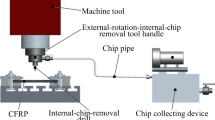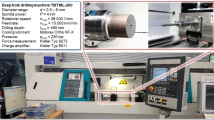Abstract
Currently, hole making processes in carbon fiber reinforced polymers (CFRP) generate powdered chips that cannot be automatically recovered in real time. The present work attempts to solve this problem using a new drilling-chip removal system called the suction-type internal chip removal system. It can discharge the powdery chips generated in the CFRP hole making process in a timely and effective manner during the drilling process. Based on the requirements of the drill bit used in this system, the following studies are carried out in this work: (1) Using statistical methods, the chips produced in CFRP hole making were classified, the chip distribution was analyzed, and the study of the influencing factors of chip size were completed; (2) based on these studies and the gas–solid two-phase fluid mechanics, a FLUENT simulation is used to define the center distance and center angle of the inner runner for the design of the drill bit. The influence of the center distance of the inner runner, the center angle of the inner runner, and the cross-sectional shape of the inner runner on the chip removal effect of the inner runner of the tool is given. Finally, by fabricating the chip removal system and drill, the correctness of the internal flow channel structure design of the internal chip removal drill was verified.
















Similar content being viewed by others
Data availability
All data generated or analyzed during this study are included in this published manuscript.
References
Wang FJ, Qian BW, Jia ZY, Fu R, Cheng D (2019) Secondary cutting edge wear of one-shot drill bit in drilling CFRP and its impact on hole quality. Compos Struct 15(178):341–352
Perez JLM, Royer R, Merson E, Lockwood A, sabino AS, Marshall MB, (2016) Influence of workpiece constituents and cutting speed on the cutting forces developed in the conventional drilling of CFRP composites. Compos Struct 140:621–629
Jia ZY, Bi GJ, Wang FJ, Wang XN, Zhang BY (2018) The research of machining mechanism of carbon fiber reinforced plastic. J Mech Eng 23(54):199–208
Wang FJ, Qian BW, Cheng D, Jia ZY, Fu R, Yin JW (2018) Wear of one-shot drill bit in drilling CFRP and novel method for tool wear reduction. J Mech Eng 54(15):171–179
Xia T, Kaynak Y, Arvin C, Jawahir IS (2016) Cryogenic cooling-induced process performance and surface integrity in drilling CFRP composite material. Int J Adv Manuf Technol 82(1–4):605–616
Liu SN, Qi ZC, LI Y, Meng QX, (2017) On full life-cycle instantaneous force predicting when drilling CFRP-metal stacks. Int J Adv Manuf Technol 88(1–4):651–661
Jia ZY, Fu R, Niu B, Qian BW, Bai Y, Wang FJ (2016) Novel drill structure for damage reduction in drilling CFRP composites. Int J Mach Tool Manu 110:55–65
Yang HJ, Chen Y, Xu JH, Ladonne M, Lonfier J, Fu YC (2019) Tool wear mechanism in low-frequency vibration–assisted drilling of CFRP/Ti stacks and its individual layer. Int J Adv Manuf Technol 104(5–8):2539–2551
Wang XC, Shen XT, Zeng C, Sun FH (2018) Combined influences of tool shape and as-deposited diamond film on cutting performance of drills for CFRP machining. Surf Coat Tech 347(15):390–397
Girot F, Dau F, Gutierrez OM (2017) New analytical model for delamination of CFRP during drilling. J Mater Process Tech 240:332–343
Gaugel S, Sripathy P, Haeger A, Meinhard D, Bernthaler T, Lissek F, Kaufeld M, Knoblauch V, schneider G, (2016) A comparative study on tool wear and laminate damage in drilling of carbon-fiber reinforced polymers (CFRP). Compos Struct 155(1):173–183
Dai QX, Ding XY, Xu HF, Liu CH, Ju TH (2020) Numerical simulation of conveying characteristics of dense phase pulverized coal in bend pipe. Journal of Iron and Steel Research 32(5):377–385
Li ZH, Li XC, Liu GM (2016) Numerical simulation and analysis on pneumatic conveying of carbon black in bend pipeline. China Rubber Industry 62(8):495–498
Ji SC (2016) (2016) Numerical simulation of airflow distribution in electrostatic precipitator. Chinese Journal of Environmental Engineering 10(4):1959–1960
Ottjes JA (2001) Digital simulation of pneumatic particle transport. Chem Eng Sci 33(6):783–786
Lu Y, Tong ZB, Glass DH, Easson WJ, Ye M (2017) Experimental and numerical study of particle velocity distribution in the vertical pipe after a 90° elbow. Powder Technol 314:500–509
Sommerfeld M, Lain S (2015) Parameters influencing dilute-phase pneumatic conveying through pipe systems: a computational study by the Euler/Lagrange approach. Can J Chem Eng 93(1):1–17
Dzido G, Palica M, Raczek J (2002) Investigations of the acceleration region in the vertical pneumatic conveying. Powder Technol 127(2):99–106
Xu CY, Wang YW, Xu JZ, Liu XL (2018) Calculation of negative-pressure chip in suction-type internal chip removal system and analysis of influencing factors. Int J Adv Manuf Technol 99(1–4):201–209
Wang YW, Xu CY, Xu JZ, Liu XL (2019) Simulation analysis and experimental study on chip removal conditions of internal chip removal bits for CFRP machining. J Mech Eng 55(5):223–231
Xu CY, Wang YW, Xu JZ, Liu XL (2019) Design of internal-chip-removal drill for CFRP drilling and study of influencing factors of drilling quality. Int J Adv Manuf Technol 106:1657–1669
Funding
This study was financially supported by the Shenyang Aerospace University Expo project (120421007) and the National Defense Science and Technology Innovation Special Zone Fund Project (208052020162).
Author information
Authors and Affiliations
Contributions
Theoretical analysis and model construction were completed by Xu Chengyang, Wang Yiwen, and Zou Aili. The experimental design and analysis were completed by Xu Chengyang and Jin Lei. The thesis was written by Xu Chengyang, Yao Songyang, and Wang Meng. The supervision and optimization of the paper were completed by Wang Yiwen and Wang Gongdong.
Corresponding author
Ethics declarations
Ethics approval
Not applicable.
Consent to participate
Not applicable.
Consent for publication
The authors consent to publish this article.
Competing interests
The authors declare no competing interests.
Additional information
Publisher's Note
Springer Nature remains neutral with regard to jurisdictional claims in published maps and institutional affiliations.
Rights and permissions
About this article
Cite this article
Wang, M., Xu, C., Zou, A. et al. Design of internal flow passage of internal chip removal drill for suction-type internal chip removal system. Int J Adv Manuf Technol 119, 4191–4202 (2022). https://doi.org/10.1007/s00170-021-08430-3
Received:
Accepted:
Published:
Issue Date:
DOI: https://doi.org/10.1007/s00170-021-08430-3




